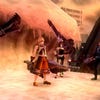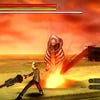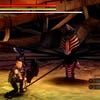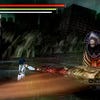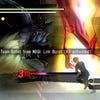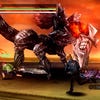Gods Eater Burst
Aragami Killer.
Each player wields a weapon called a God Arc which can morph between three functions mid-battle – Gun, Sword and Shield. These function exactly as you'd expect. Each type has three subcategories which, in the case of Gun, include Sniper, Assault and Blast.
In effect, this means each player has ranged, melee and defensive options at their disposal. Although the subcategories determine whether you're a speedy Short Sword or a lumbering Buster Sword, they only provide limited variety when compared to Gunlances, Switch Axes and Hunting Horns. Because no matter how you look at it, the game-plan of an Assault, Long and Buckler user will not be all that different from a Blast, Buster and Tower player.
That's not a negative criticism of God Eater per se, more an observation of its intent. This isn't a game which forces you to make tough decisions. Instead it offers subtle customisation options which let you find a setup to suit your style of play.
While the controls are tricky to tame on the ill equipped PSP, with practise, they'll let you switch between God Arc forms on the fly with a speed that's more akin to Phantasy Star.
You can jump, run, dash, block and lock-on to opponents while mixing up light and heavy attacks for some simple combos. Gun mode requires you to build up metre with melee strikes, which can then be used as ammunition.
"God Eater is a game designed for people who like the idea of Monster Hunter ... but find the game too demanding."
Bullet customisation is a massive part of what makes God Eater stand out, with everything from elemental properties to trajectory being entirely tuneable. You can even make a flamethrower designed to heal your teammates.
The other element which makes God Eater unique is the Devour ability. This takes the form of a charge attack which forms a massive set of jaws around the God Arc. Once it's fully charged, you can take a bite out of the enemy.
If the Aragami is still alive, this will temporarily put your character into a Burst state, increasing their speed and damage output. As an extra bonus, a successful Devour will net you some Aragami Bullets which will expire once the mission is over. If the Aragami is dead, however, Devour will function as a carving tool which lets you munch on its corpse for three randomly determined parts. These are used to craft weapons in the usual fashion.
The game also has its far share of statistical fluff. Weapons are graded on their Sunder, Crush and Pierce attributes, as well as 130 Skills which range from beneficial perks like God of Rare Drops to de-uffs like Out of Shape. Unfortunately, the Aragami aren't quite so numerous.
God Eater offers little over ten enemy types that come in variations like Fallen, Fire, Thunder and Ice. There isn't a great deal of variety, but the few Aragami who feature are beautifully animated.
Highlights include the Chi You mech-bird and the Sariel human-butterfly. While they're not a patch on a Rathalos or a Lagiacrus, they're at least varied enough to offer an alternative to Monster Hunter's draconic stable.
In the end, God Eater is a game designed for people who like the idea of Monster Hunter, but for whatever reason – whether it's sharpening your weapon, eating steaks for stamina, laying traps for captures, being stampeded by an enraged Barroth or failing to bag a Deviljho Gem for the tenth consecutive time – find the game too demanding.
In God Eater, the time limit is set to 30 minutes. More often than not, you'll have ample time to spare.
The game is already a year old in Japan and has largely been overshadowed by the release of Monster Hunter Portable 3rd, which has shifted over 4 million copies. This engaging alternative manages to sidestep allegations of being Monster Hunter Lite - but only just.




